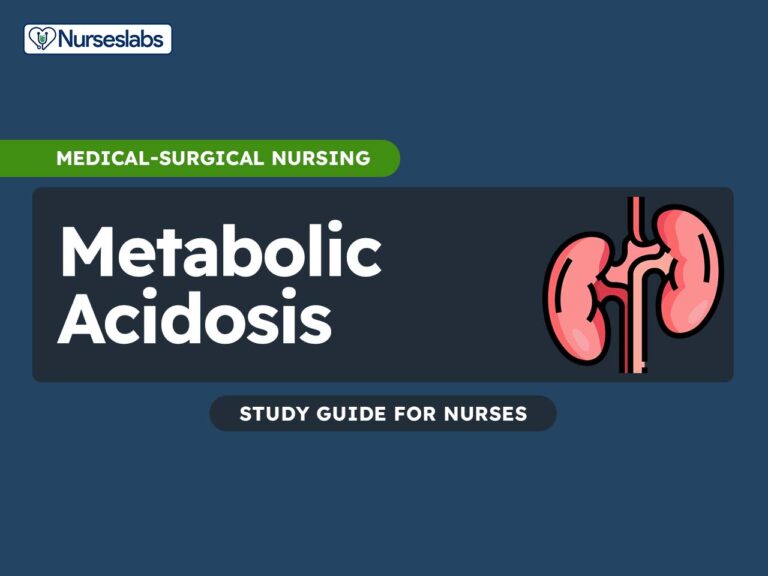Definition
Metabolic Acidosis is an acid-base imbalance resulting from excessive absorption or retention of acid or excessive excretion of bicarbonate produced by an underlying pathologic disorder. Symptoms result from the body’s attempts to correct the acidotic condition through compensatory mechanisms in the lungs, kidneys and cells.
Metabolic acidosis is characterized by normal or high anion gap situations. If the primary problem is direct loss of bicarbonate, gain of chloride, or decreased ammonia production, the anion gap is within normal limits. If the primary problem is the accumulation of organic anions (such as ketones or lactic acid), the condition is known as high anion gap acidosis. Compensatory mechanisms to correct this imbalance include an increase in respirations to blow off excess CO2, an increase in ammonia formation, and acid excretion (H+) by the kidneys, with retention of bicarbonate and sodium.
High anion gap acidosis occurs in diabetic ketoacidosis; severe malnutrition or starvation, alcoholic lactic acidosis; renal failure; high-fat, low-carbohydrate diets/lipid administration; poisoning, e.g., salicylate intoxication (after initial stage); paraldehyde intoxication; and drug therapy, e.g., acetazolamide (Diamox), NH4Cl.
Normal anion gap acidosis is associated with loss of bicarbonate form the body, as may occur in renal tubular acidosis, hyperalimentation, vomiting/diarrhea, small-bowel/pancreatic fistulas, and ileostomy and use of IV sodium chloride in presence of preexisting kidney dysfunction, acidifying drugs (e.g., ammonium chloride).
Care Setting
This condition does not occur in isolation but rather is a complication of a broader problem that may require inpatient care in a medical-surgical or subacute unit.
Related Concerns
- Plans of care specific to predisposing factors
- Fluid and electrolyte imbalances
- Renal dialysis
- Respiratory acidosis (primary carbonic acid excess)
- Respiratory alkalosis (primary carbonic acid deficit)
Causes
- Anaerobic carbohydrate metabolism
- Renal insufficiency and failure
- Diarrhea and intestinal malabsorption
- ketoacidosis
- lactic acidosis
- prolonged fasting
- salicylate poisoning
- oliguric renal disease
- abnormal bicarbonate losses, which can occur in loss of fluid from the lower GI tract from surgery, drains or severe diarrhea
Complications
- Coma
- Arrhythmias
- Cardiac arrest
Signs and symptoms
- headache
- drowsiness and confusion
- weakness
- increased respiratory rate and depth
- nausea and vomiting
- diminished cardiac output with pH below 7, which results in hypotension, cold clammy skin and cardiac arrhythmias.
Assessment
ACTIVITY/REST
CIRCULATION
- May exhibit: Hypotension, wide pulse pressure
- Pulse may be weak, irregular (dysrhythmias)
- Jaundiced sclera, skin, mucous membranes (liver failure)
ELIMINATION
- May report: Diarrhea
- May exhibit: Dark/concentrated urine
FOOD/FLUID
NEUROSENSORY
- May report: Headache, drowsiness, decreased mental function
- May exhibit: Changes in sensorium, e.g., stupor, confusion, lethargy, depression, delirium, coma
- Decreased deep-tendon reflexes, muscle weakness
RESPIRATION
- May report: Dyspnea on exertion
- May exhibit: Hyperventilation, Kussmaul’s respirations (deep, rapid breathing)
SAFETY
- May report: Transfusion of blood/blood products
- Exposure to hepatitis virus
- May exhibit: Fever, signs of sepsis
TEACHING/LEARNING
- History of alcohol abuse
- Use of carbonic anhydrase inhibitors or anion-exchange resins, e.g., cholestyramine (Questran)
Diagnostic Studies
- CONFIRMING DIAGNOSIS: Arterial pH below 7.35 confirms metabolic acidosis. In severe acidotic states, pH may fall to 7.10 and the partial pressure of arterial carbon dioxide may be normal or below 34 mmHg. Bicarbonate may be below 22 mEq/L.
- Urine pH: below 4.5 in the absence of renal disease.
- Serum potassium levels: above 5.5 mEq/L from chemical buffering.
- Glucose levels: above 150 mg/dl in diabetics.
- Arterial pH: Decreased, less than 7.35.
- Bicarbonate (HCO3): Decreased, less than 22 mEq/L.
- Paco2: Less than 35 mm Hg.
- Base excess: Negative.
- Anion gap: Higher than 14 mEq/L (high anion gap) or range of 10–14 mEq/L (normal anion gap).
- Serum potassium: Increased (except in diarrhea, renal tubular acidosis).
- Serum chloride: Increased.
- Serum glucose: May be decreased or increased depending on etiology.
- Serum ketones: Increased in DM, starvation, alcohol intoxication.
- Plasma lactic acid: Elevated in lactic acidosis.
- Urine pH: Decreased, less than 4.5 (in absence of renal disease).
- ECG: Cardiac dysrhythmias (bradycardia) and pattern changes associated with hyperkalemia, e.g., tall T wave.
Nursing Priorities
- Achieve homeostasis.
- Prevent/minimize complications.
- Provide information about condition/prognosis and treatment needs as appropriate.
Discharge Goals
- Physiological balance restored.
- Free of complications.
- Condition, prognosis, and treatment needs understood.
- Plan in place to meet needs after discharge
Nursing Care Plan
Main Article: Metabolic Acidosis Nursing Care Plan
Treatment
- Administration of sodium bicarbonate I.V. for severe cases
- Evaluation and correction of electrolyte imbalances and ultimately correction and management of the underlying cause.
Nursing Interventions & Considerations
- Keep sodium bicarbonate ampules handy for emergency administration.
- Monitor vital signs, laboratory results and level of consciousness frequently.
- Watch out for signs of decreasing level of consciousness.
- Record intake and output accurately to monitor renal function.
- For management of vomiting (common to metabolic acidosis), position the patient to prevent aspiration.
- Prepare for possible seizures and administer appropriate precautions.
- Provide good oral hygiene after incidences of vomiting. Use sodium bicarbonate washes to neutralize acid in the patient’s mouth.
